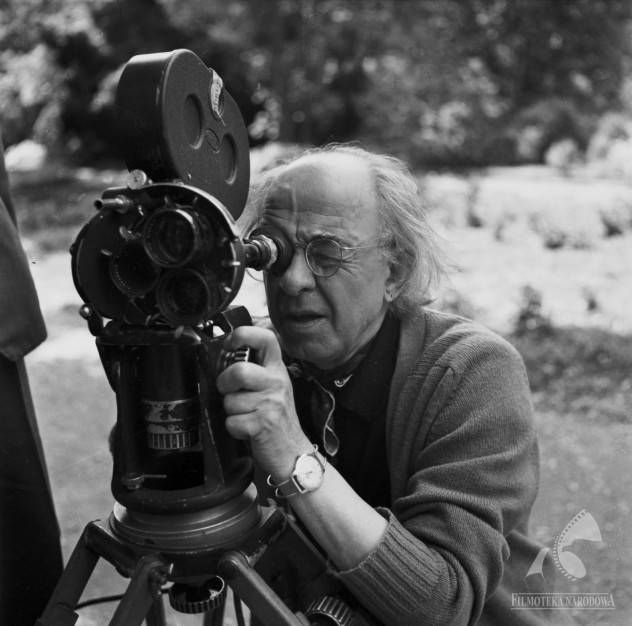foto mix
Leonard Zajączkowski
(born 1902 in Warsaw, died 1979 in Warsaw) An outstanding Polish cinematographer, before the war worked for the Polish Telegraph Agency, after the war - for the Polish Film Chronicle (PFC). During 25 years of work for the PFC, he covered 1885 themes, including 1775 Warsaw themes1. As author and cinematographer, he was particularly interested in culture and medicine.

In the film milieu, he enjoyed high esteem already before the war. In 1921, he began attending cinematography school “Kinostudia" established by i.a. Stanisława Wysocka, Wiktor Biegański and Edward Puchalski. There, under the tutelage of painter and photographer Kirchner, he probably learned photography and acting. Shortly afterwards, he played bit parts in a few films, but above all, he started working as still photographer and very quickly became a specialist in this field.
Zajączkowski ran his own film photography art studio, first at Leszno 108 street and then at Chmielna 27 street. Ludwik Perski, a film director, said: “Tadeusz Wesołowski, a Warsaw actor, famous before the war, took me to the film set of the movie »Ułani, ułani« (...). One member of the film crew (...) was also Zajączkowski, already a well-known and respected film still photographer. It’s worth mentioning that in our film industry there were only two specialists in this field at that time. One of them was Józef Frankfurt (his name was actually Maksymilian Frankfurt – editorial note) and the second one – Zajączkowski. These two “monopolised" the film photography market. They made stills for over 90% of all films shot at that time. (...) I saw many photographs made by Leonard. These were solid pieces of work presenting high artistic level"2. Unfortunately, rich photograph and negative archives of Zajączkowski burned down during the Warsaw uprising.
At the end of the war, in 1944, he went to the Polish Army Film Studio [Wytwórnia Filmowa Wojska Polskiego] in Lublin. He made first portrait photographs of the Interim Government members there. Zajączkowski started working for PFC in 1949. At the end of his life, he had a supporting role of an old chronicle cinematographer in the film “Man of Marble" by Andrzej Wajda. “Leonard was exactly the same as shown by Andrzej Wajda" - said film director, Jerzy Bosak. “Impulsive, excited, full of temperament, open, a bit funny but in the way really talented people, who entirely devoted to their work are funny"3.
Zajączkowski was awarded the Knight’s Cross of the Order of Polonia Restituta, Silver Cross of Merit, and Distinguished Cultural Service Award.
Piotr Śmiałowski
Filmography of Zajączkowski as still photographer (incomplete)4:
1928 – „Przeznaczenie”
1928 – „Dzikuska”
1928 – „Huragan”
1928 – „Przedwiośnie”
1929 – „Tajemnica skrzynki pocztowej”
1929 – „Z dnia na dzień”
1929 – „Pod banderą miłości”
1929 – „Policmajster Tagiejew”
1932 – „Rycerze mroku”
1932 – „Bezimienni bohaterowie”
1932 – „Dzikie pola”
1932 – „Ułani, ułani, chłopcy malowani”
1933 – „Wyrok życia” (wespół z Maksymilianem Frankfurtem)
1933 – „Szpieg w masce” (wespół z Maksymilianem Frankfurtem)
1933 – „Każdemu wolno kochać”
1933 – „Zabawka”
1934 – „Przeor Kordecki – obrońca Częstochowy”
1935 – „Panienka z poste restante”
1935 – „Dzień wielkiej przygody”
1935 – „Manewry miłosne”
1936 – „Tajemnica panny Brinx”
1935 – „Pan Twardowski”
1936 – „Róża”
1936 – „Barbara Radziwiłłówna”
1937 – „Ordynat Michorowski”
1937 – „Dziewczyna szuka miłości”
1937 – „Ty, co w ostrej świecisz bramie”
1937 – „Pan redaktor szaleje”
1937 – „Trójka hultajska”
1938 – „Zapomniana melodia”
1938 – „Moi rodzice rozwodzą się”
1939 – „Włóczęgi”
1939 – „U kresu drogi”
1939 – „Trzy serca”
1939 – „Biały murzyn”
1. Information from: H. Rutkowska, Leonard Zajączkowski – wspomnienie o operatorze, "Ekran", 1979, No. 12
2. L. Perski, Leonard Zajączkowski – wspomnienie o operatorze, rozm. przepr. H. Rutkowska, "Ekran", 1979, No. 12
3. J. Bossak, Leonard Zajączkowski – wspomnienie o operatorze, rozm. przepr. H. Rutkowska, "Ekran", 1979, No. 12
4. Most of the information about the authorship of pre-war stills comes from original programmes for specific movies




